stop start Alfa Romeo MiTo 2012 Owner handbook (in English)
[x] Cancel search | Manufacturer: ALFA ROMEO, Model Year: 2012, Model line: MiTo, Model: Alfa Romeo MiTo 2012Pages: 262, PDF Size: 6.46 MB
Page 56 of 262
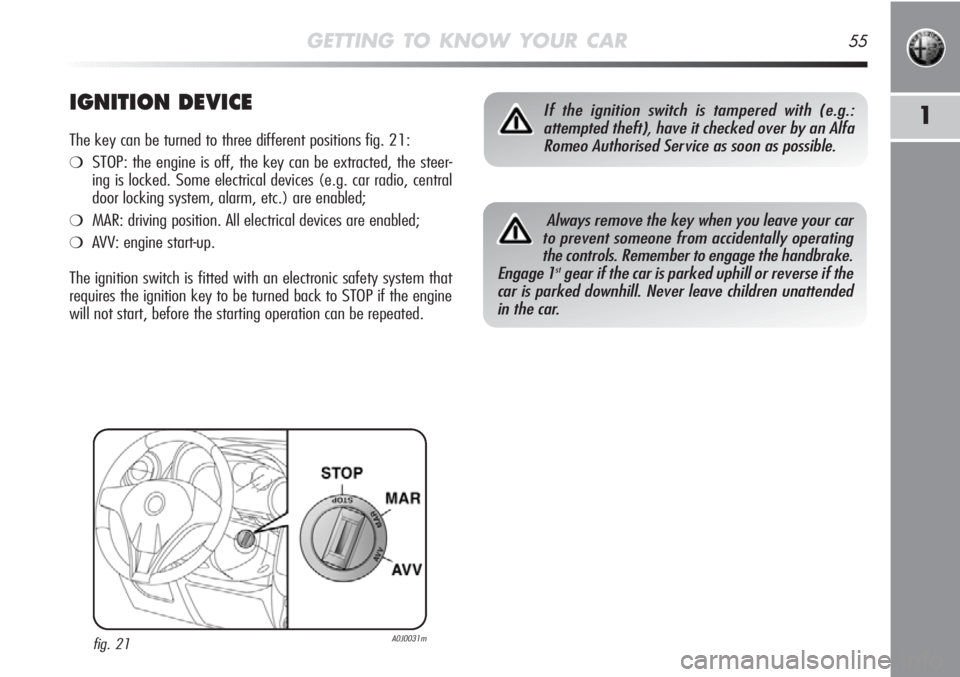
GETTING TO KNOW YOUR CAR55
1IGNITION DEVICE
The key can be turned to three different positions fig. 21:
❍STOP: the engine is off, the key can be extracted, the steer-
ing is locked. Some electrical devices (e.g. car radio, central
door locking system, alarm, etc.) are enabled;
❍MAR: driving position. All electrical devices are enabled;
❍AVV: engine start-up.
The ignition switch is fitted with an electronic safety system that
requires the ignition key to be turned back to STOP if the engine
will not start, before the starting operation can be repeated.
fig. 21A0J0031m
If the ignition switch is tampered with (e.g.:
attempted theft), have it checked over by an Alfa
Romeo Authorised Service as soon as possible.
Always remove the key when you leave your car
to prevent someone from accidentally operating
the controls. Remember to engage the handbrake.
Engage 1
stgear if the car is parked uphill or reverse if the
car is parked downhill. Never leave children unattended
in the car.
Page 75 of 262
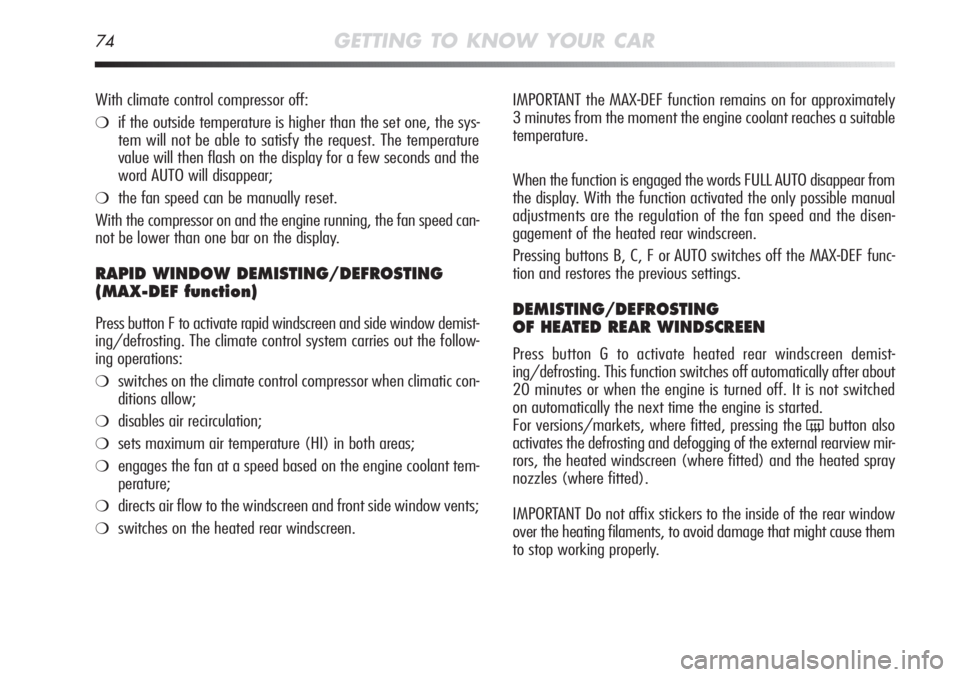
74GETTING TO KNOW YOUR CAR
IMPORTANT the MAX-DEF function remains on for approximately
3 minutes from the moment the engine coolant reaches a suitable
temperature.
When the function is engaged the words FULL AUTO disappear from
the display. With the function activated the only possible manual
adjustments are the regulation of the fan speed and the disen-
gagement of the heated rear windscreen.
Pressing buttons B, C, F or AUTO switches off the MAX-DEF func-
tion and restores the previous settings.
DEMISTING/DEFROSTING
OF HEATED REAR WINDSCREEN
Press button G to activate heated rear windscreen demist-
ing/defrosting. This function switches off automatically after about
20 minutes or when the engine is turned off. It is not switched
on automatically the next time the engine is started.
For versions/markets, where fitted, pressing the
(button also
activates the defrosting and defogging of the external rearview mir-
rors, the heated windscreen (where fitted) and the heated spray
nozzles (where fitted).
IMPORTANT Do not affix stickers to the inside of the rear window
over the heating filaments, to avoid damage that might cause them
to stop working properly. With climate control compressor off:
❍if the outside temperature is higher than the set one, the sys-
tem will not be able to satisfy the request. The temperature
value will then flash on the display for a few seconds and the
word AUTO will disappear;
❍the fan speed can be manually reset.
With the compressor on and the engine running, the fan speed can-
not be lower than one bar on the display.
RAPID WINDOW DEMISTING/DEFROSTING
(MAX-DEF function)
Press button F to activate rapid windscreen and side window demist-
ing/defrosting. The climate control system carries out the follow-
ing operations:
❍switches on the climate control compressor when climatic con-
ditions allow;
❍disables air recirculation;
❍sets maximum air temperature (HI) in both areas;
❍engages the fan at a speed based on the engine coolant tem-
perature;
❍directs air flow to the windscreen and front side window vents;
❍switches on the heated rear windscreen.
Page 80 of 262

GETTING TO KNOW YOUR CAR79
1
Moving the lever upwards (unstable position) limits operation to
the time the lever is held in this position. The lever will return to
position and the wiper will be automatically stopped when released.WINDOW WASHING
The right lever controls windscreen wiper/washer and heated rear
window wiper/washer operation.
WINDSCREEN WIPER/WASHER fig. 34
This only operates with the ignition turned to MAR. Selector wheel
A can take five different positions:
,intermittent (low speed);
Owindscreen wiper off;
AUTO rain sensor activation (for versions/markets, where pro-
vided) (the windscreen wipers adapt the operating speed
automatically to suit the intensity of the rain)
≤intermittent;
≥continuous slow;
¥continuous fast operation.
fig. 34A0J0064m
Do not use the windscreen wiper to remove lay-
ers of snow or ice from the windscreen. In such con-
ditions, the windscreen wiper may be subjected to
excessive stress and the motor protection which prevents
operation for a few seconds may trip. If operation is not
restored, even after turning the key and restarting the en-
gine, contact an Alfa Romeo Authorised Service.
“Smart washing” function
Pull the lever towards the steering wheel (unstable position) to op-
erate the windscreen washer jet. By keeping the lever pulled for
more than half a second, it is possible to operate the washer jet
and the wiper at the same time with just one movement.
The wiper stops working three strokes after releasing the lever. A
further stroke after approx. 6 seconds completes the wiping cycle.
Page 93 of 262

92GETTING TO KNOW YOUR CAR
ELECTRIC SUNROOF
(for versions/markets, where provided)
The extensively glazed sun roof comprises a moving glass panel
and a sun blind. The glazed panel, when closed, allows light from
the outside to enter and makes it possible to see the outside from
the passenger compartment.
When it opens the front glass panel slides towards the outside of
the roof.
OPERATION
The sun roof is operated by pressing buttons A and B-fig. 53 located
on the trim next to the middle courtesy light.
The sun roof can only be operated with the ignition key in the MAR
position.
Roof opening
Pressing button A-fig. 53 allows two opening modes for the front glass
panel.
Automatic
If button A-fig. 53 is pressed for a while, the front glass panel is raised
from completely closed to the spoiler position. If the button is pressed
again, the panel starts to slide backwards until it is completely open.
After the initial opening command the glass panel can be stopped in
intermediate positions by pressing the button again.
Manual
If button A-fig. 53 is pressed briefly, the front glass panel moves from
the completely closed position and stops in the position where the but-
ton is released. In this case the panel opens by pressing the actual
button.
This function makes it possible to place the front panel in intermedi-
ate positions in relation to those produced through automatic open-
ing.
fig. 53A0J0329m
The sun roof must stay closed if a transverse roof
rack is fitted.
Page 94 of 262

GETTING TO KNOW YOUR CAR93
1
Sun blind
The brightness in the passenger compartment can be adjusted by
using a sun blind.
Curtain opening:press the button A - fig. 54 to release the
curtain and then grasp the handle B and make it slide towards
the back.
Curtain closing:grasp the handle B and make the curtain slide to
the front, making sure it is locked.
Roof closing
Pressing button B-fig. 53 allows two closing modes for the front
glass panel.
Automatic
With the roof completely open, press button B-fig. 53 for a while:
the front glass panel will assume the spoiler position.
If the button is then pressed, the panel will start to slide forward
until it is completely closed.
After the initial opening command, the glass panel can be stopped
in intermediate positions by pressing the button again.
Manual
If button B-fig. 53 is pressed briefly, the front glass panel moves
from the completely open position and stops in the position where
the button is released. In this case the panel closes by pressing
the actual button.
This function makes it possible to place the front glass panel in in-
termediate positions in relation to those produced through auto-
matic closing.
When leaving the car, always remove the key from
the ignition device to avoid the risk of injury due
to accidental operation of the sun roof; it presents
a risk to those left on board: improper use of the roof can
be dangerous. Before operation, always check that no-
one is at risk of being injured by the moving sun roof or
by objects getting caught and dragged by it.
Do not open the sun roof in the presence of snow
or ice: it may be damaged.
fig. 53A0J0157m
Page 107 of 262
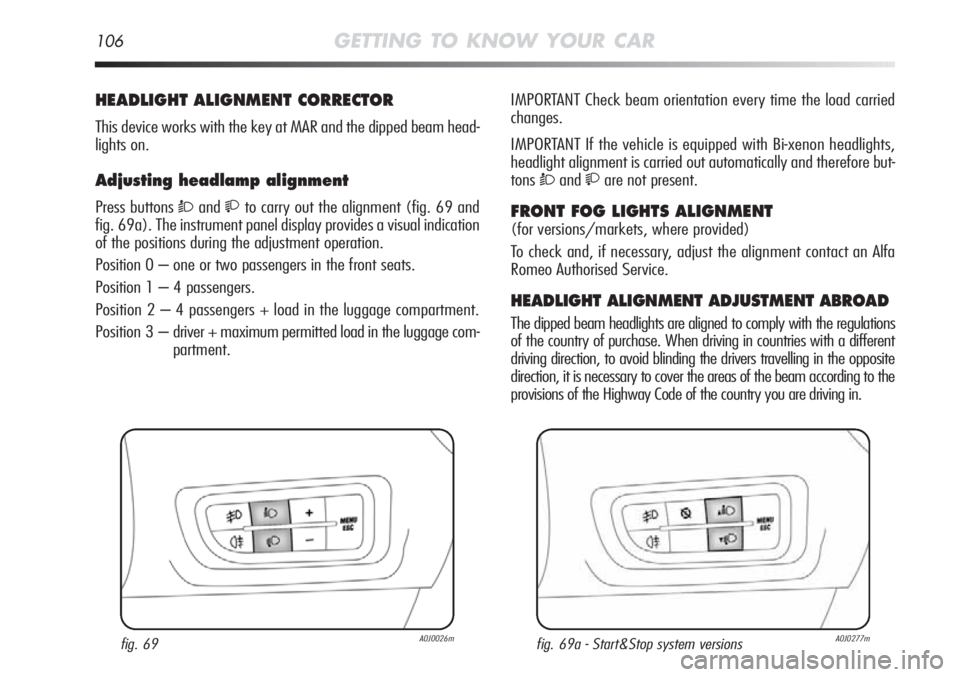
106GETTING TO KNOW YOUR CAR
HEADLIGHT ALIGNMENT CORRECTOR
This device works with the key at MAR and the dipped beam head-
lights on.
Adjusting headlamp alignment
Press buttons Òandto carry out the alignment (fig. 69 and
fig. 69a). The instrument panel display provides a visual indication
of the positions during the adjustment operation.
Position 0 – one or two passengers in the front seats.
Position 1 – 4 passengers.
Position 2 – 4 passengers + load in the luggage compartment.
Position 3 – driver + maximum permitted load in the luggage com-
partment.IMPORTANT Check beam orientation every time the load carried
changes.
IMPORTANT If the vehicle is equipped with Bi-xenon headlights,
headlight alignment is carried out automatically and therefore but-
tons
Òandare not present.
FRONT FOG LIGHTS ALIGNMENT
(for versions/markets, where provided)
To check and, if necessary, adjust the alignment contact an Alfa
Romeo Authorised Service.
HEADLIGHT ALIGNMENT ADJUSTMENT ABROAD
The dipped beam headlights are aligned to comply with the regulations
of the country of purchase. When driving in countries with a different
driving direction, to avoid blinding the drivers travelling in the opposite
direction, it is necessary to cover the areas of the beam according to the
provisions of the Highway Code of the country you are driving in.
fig. 69A0J0026mfig. 69a - Start&Stop system versionsA0J0277m
Page 115 of 262
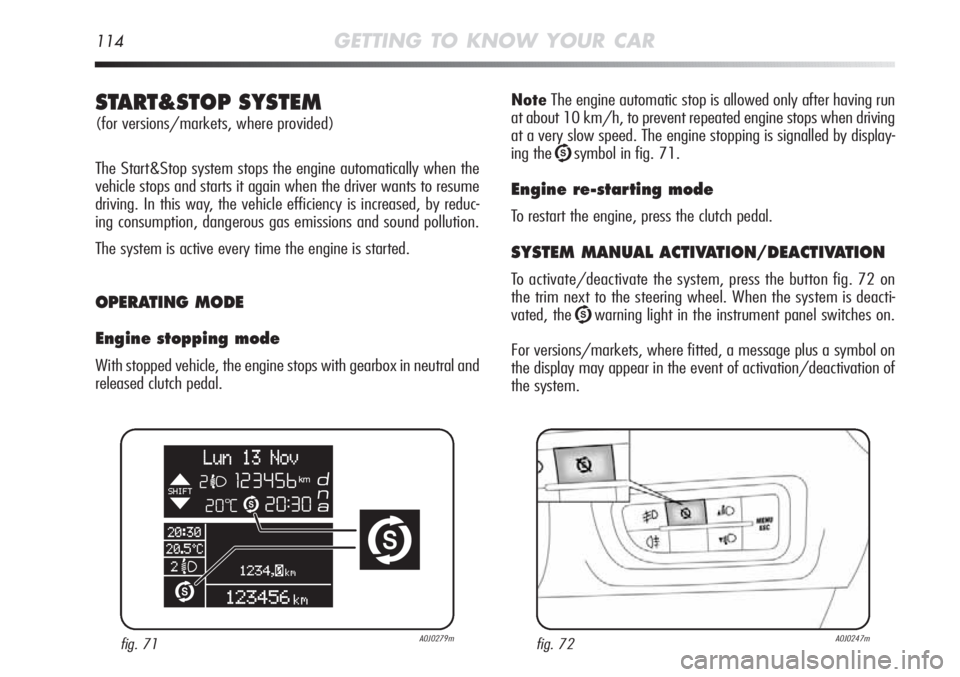
114GETTING TO KNOW YOUR CAR
NoteThe engine automatic stop is allowed only after having run
at about 10 km/h, to prevent repeated engine stops when driving
at a very slow speed. The engine stopping is signalled by display-
ing the
Usymbol in fig. 71.
Engine re-starting mode
To restart the engine, press the clutch pedal.
SYSTEM MANUAL ACTIVATION/DEACTIVATION
To activate/deactivate the system, press the button fig. 72 on
the trim next to the steering wheel. When the system is deacti-
vated, the
Uwarning light in the instrument panel switches on.
For versions/markets, where fitted, a message plus a symbol on
the display may appear in the event of activation/deactivation of
the system.
START&STOP SYSTEM
(for versions/markets, where provided)
The Start&Stop system stops the engine automatically when the
vehicle stops and starts it again when the driver wants to resume
driving. In this way, the vehicle efficiency is increased, by reduc-
ing consumption, dangerous gas emissions and sound pollution.
The system is active every time the engine is started.
OPERATING MODE
Engine stopping mode
With stopped vehicle, the engine stops with gearbox in neutral and
released clutch pedal.
fig. 71A0J0279mfig. 72A0J0247m
Page 116 of 262
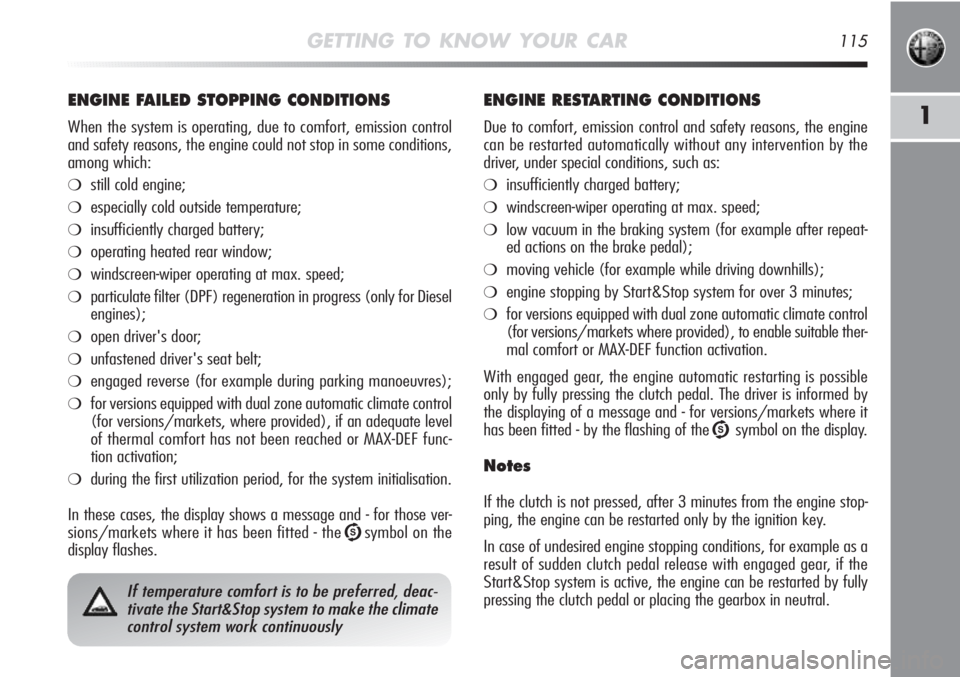
GETTING TO KNOW YOUR CAR115
1
ENGINE FAILED STOPPING CONDITIONS
When the system is operating, due to comfort, emission control
and safety reasons, the engine could not stop in some conditions,
among which:
❍still cold engine;
❍especially cold outside temperature;
❍insufficiently charged battery;
❍operating heated rear window;
❍windscreen-wiper operating at max. speed;
❍particulate filter (DPF) regeneration in progress (only for Diesel
engines);
❍open driver's door;
❍unfastened driver's seat belt;
❍engaged reverse (for example during parking manoeuvres);
❍for versions equipped with dual zone automatic climate control
(for versions/markets, where provided), if an adequate level
of thermal comfort has not been reached or MAX-DEF func-
tion activation;
❍during the first utilization period, for the system initialisation.
In these cases, the display shows a message and - for those ver-
sions/markets where it has been fitted - the
Usymbol on the
display flashes.
ENGINE RESTARTING CONDITIONS
Due to comfort, emission control and safety reasons, the engine
can be restarted automatically without any intervention by the
driver, under special conditions, such as:
❍insufficiently charged battery;
❍windscreen-wiper operating at max. speed;
❍low vacuum in the braking system (for example after repeat-
ed actions on the brake pedal);
❍moving vehicle (for example while driving downhills);
❍engine stopping by Start&Stop system for over 3 minutes;
❍for versions equipped with dual zone automatic climate control
(for versions/markets where provided), to enable suitable ther-
mal comfort or MAX-DEF function activation.
With engaged gear, the engine automatic restarting is possible
only by fully pressing the clutch pedal. The driver is informed by
the displaying of a message and - for versions/markets where it
has been fitted - by the flashing of the
Usymbol on the display.
Notes
If the clutch is not pressed, after 3 minutes from the engine stop-
ping, the engine can be restarted only by the ignition key.
In case of undesired engine stopping conditions, for example as a
result of sudden clutch pedal release with engaged gear, if the
Start&Stop system is active, the engine can be restarted by fully
pressing the clutch pedal or placing the gearbox in neutral.
If temperature comfort is to be preferred, deac-
tivate the Start&Stop system to make the climate
control system work continuously
Page 117 of 262

116GETTING TO KNOW YOUR CAR
SAFETY CONDITIONS
When the engine is stopped by the Start&Stop system, if the dri-
ver releases his/her seat belt and opens the driver's or passenger's
door, the engine can be restarted only by the ignition key.
This condition is signalled by a buzzer and by a displayed message
and - for versions/markets where it has been fitted - by the flash-
ing of the
Usymbol on the display.
"ENERGY SAVING" FUNCTION
(for versions/markets, where provided)
If, as a result of the engine automatic restarting, the driver does not
make any action on the vehicle for over 3 minutes, the Start&Stop
system stops the engine once and for all, to prevent fuel consump-
tion. In these cases, the engine can be restarted only by the igni-
tion key.
Note In any case, the engine can be still kept running by deactivat-
ing the Start&Stop system.
OPERATING IRREGULARITIES
In case of malfunctioning conditions, the Start&Stop system is
deactivated. The driver is informed about the failure through the
switching-on of the warning light
èon the instrument panel and
- for versions/markets where it has been fitted - through the dis-
playing of a message + symbol. In this case, contact Alfa Romeo
Authorised Service.
Page 118 of 262

GETTING TO KNOW YOUR CAR117
1
CAR INACTIVITY
(with Start&Stop system with dummy pole)
(for versions/markets where provided)
In case of vehicle inactivity conditions, pay special attention to
the disconnection of the battery power supply. The procedure must
be made by disconnecting the quick release negative terminal
A-fig. 73 from the dummy negative pole B, as the battery nega-
tive pole C has a sensor D for battery condition monitoring that
must never be disconnected (unless the battery is replaced).
CAR INACTIVITY
(with Start&Stop system without dummy pole)
(for versions/markets where provided)
In case of car inactivity, special attention must be paid due to the
disconnection of the battery power supply. Proceed as follows:
detach the connector A-fig. 74 (by pressing button B) from sen-
sor C for monitoring the battery status installed on the battery neg-
ative pole D. This sensor should never be disconnected from the
pole except if the battery is replaced.
fig. 73A0J0249m
In case of battery replacement, always contact
Alfa Romeo Authorised Service. Replace the bat-
tery using a new one of the same type (HEAVY
DUTY) and having the same specifications.
fig. 74A0J0207m